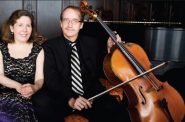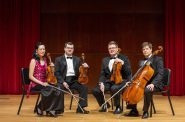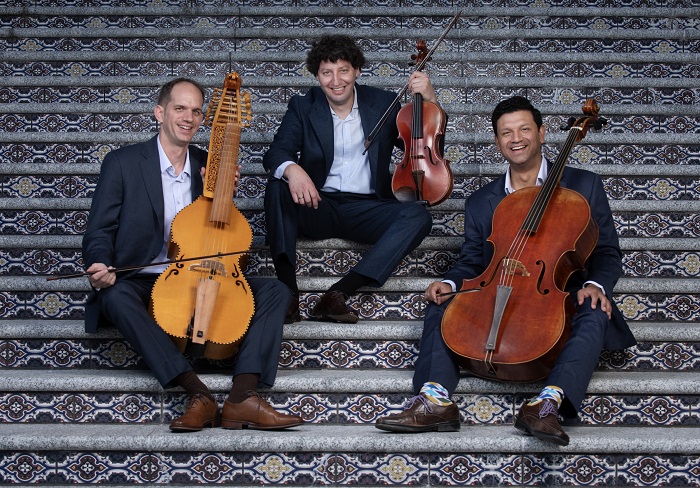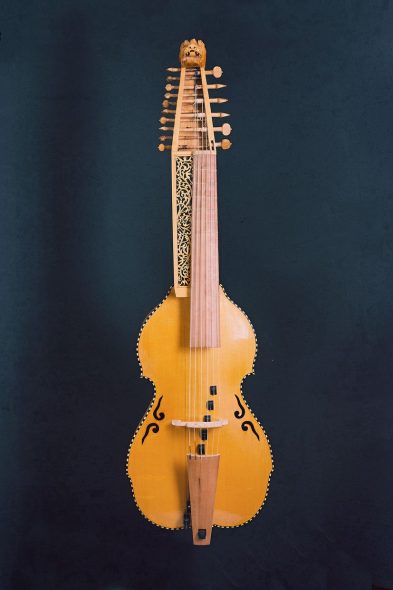Let Us Now Hear From the Baryton
Valencia Baryton Project performs works written by Haydn for once fashionable string instrument similar to viol.
Early music enthusiasts in Milwaukee will have a rare opportunity to experience the baryton, a short-lived improvement on the viola da gamba championed by the Valencia Baryton Project. Founder Mathew Baker on baryton will perform with violist Brett Walfish and cellist Ismar Gomes late Saturday afternoon at Saint Paul’s Episcopal Church as guests of the Early Music Now series.
The baryton developed from the viola da gamba—an instrument well known to regular Early Music Now audiences. While the viola da gamba produced beautiful, subtle resonances and overtones, its limited volume restricted it primarily to performances in courtly private settings rather than public performance spaces.
The baryton preserved the viola da gamba’s distinctive sound qualities while offering enough projection to blend effectively with violin family instruments in chamber music settings. Physically, it resembles a cello-sized instrument modeled on the bass viola da gamba, featuring six fretted strings. The bowing technique involves an underhand grip, which allows for dynamic control and varied articulation, giving the instrument its characteristic lightness and clarity. The result creates a warm, rich and intimate tone that is both dynamically expressive and subtly nuanced.
What makes the baryton unique is its design enhancement: ten additional strings positioned below the main strings. These extra strings vibrate sympathetically with the bowed strings, enriching the tone. Alternatively, the left thumb can pluck them from behind the instrument, producing a distinctly different sound.
Influential composer Joseph Haydn (1732-1809), widely recognized as the father of piano trios, symphonies, and string quartets, should also be acknowledged as the father of baryton compositions. He wrote an impressive 126 trios for the instrument, along with various pieces for other ensembles.
This prolific output occurred because Haydn served as composer and director for Prince Esterházy‘s estate orchestra near Vienna. When the Prince acquired a baryton, he directed Haydn, as his court composer, to write music for the instrument resulting in the substantial repertoire we have today. Haydn wrote many trios for baryton, viola, and cello as he learned how to take full advantage of the plucked back strings. As classical music developed and key progressions became important to development, the baryton was less flexible as the ten back strings were tuned to one key – D Major.
Baker, a professor of jazz and contemporary music at Berklee College of Music Valencia, Spain, purchased a modern baryton and embarked on an ambitious project to record Haydn’s complete works for the instrument. The first CD was remarkably successful, appearing in Gramophone’s top 20 Classical charts in the UK and All Music’s Top Classical CDs of 2021.
A reviewer for Die Welt exclaimed:
One can maximize the minimal without driving out the elegance, the dance-like, the intimacy and the immediacy, for which there is no better instrument than the baryton. Which in turn is perfectly demonstrated by the Valencia Baryton Project. … Apparently small music can be this big. You can’t get enough of it.
This success encouraged the Valencia Baryton Project to commit to a series of recordings. Having published their second album, they are now preparing for a third.
The trio format itself is distinctive—the combination of baryton, viola, and cello creates a rich sound in the lower register. The close pitch between the three instruments forced Haydn to be creative with how he developed textures. Baker describes the music.
In many movements you’ll hear the viola and the baryton playing in unison, not even in octaves, but in flat-out unison. If you can get that dead in tune it creates this weird soundscape. You’ve got the resonance of the back strings, a nasal tone in the front strings, and when it’s in unison the viola has a little bit woodier texture to it. The cello may be more independent, but the tightly interwoven parts between the baryton and viola are lovely.
Many of the works scheduled for Milwaukee’s concert are accessible on YouTube. See Haydn’s Trio in A Minor, Hob. XI:87 on the Valencia Project’s first CD and Haydn’s Trio in G Major, Hob. XI:67 on the second.
By the way, Baker will be returning to the United States and Canada next year for a jazz tour with French pianist, Baptiste Bailly. Generally a double bass player, Baker has been adapting the baryton to jazz.
The consistency of the music and the clarity of this particular ensemble, as evidenced by reviews of their previous recordings, showcases the rich sound created by this instrument. Particularly in the hands of Haydn, who developed a remarkable finesse in writing for this new instrument despite its limited range, the baryton offers a unique listening experience. This concert represents a rare opportunity for Milwaukee audiences to hear this historical instrument performed at the highest level by dedicated specialists.
The Valencia Baryton Project concert begins at 5:00 p.m., March 1 at St. Paul’s Episcopal Church (914 E. Knapp St., Milwaukee, 53202.) There will be a pre-concert lecture in Saint Paul’s Great Hall at 4:00 p.m. Tickets can be ordered at this link. Parking is available on the street, and in the Lincoln Center of the Arts lot just across Marshall St. The accessibility ramp is located through the garden on Knapp St., just east of the main entrance.
On April 26, Early Music Now features the Magdalena Ensemble, named as one of Early Music America’s 2024 Emerging Artists. The program, Scenes from a French Landscape, presents the music of Renaissance France.
If you think stories like this are important, become a member of Urban Milwaukee and help support real, independent journalism. Plus you get some cool added benefits.
Preview
-
Prometheus Performs Pulitzer Winning Composer
 Feb 14th, 2025 by Martha Brown
Feb 14th, 2025 by Martha Brown
-
Moby Dick to Land in Milwaukee
 Feb 10th, 2025 by Michael Barndt
Feb 10th, 2025 by Michael Barndt
-
A Musical Trip to Western Europe
 Feb 6th, 2025 by Michael Barndt
Feb 6th, 2025 by Michael Barndt





















